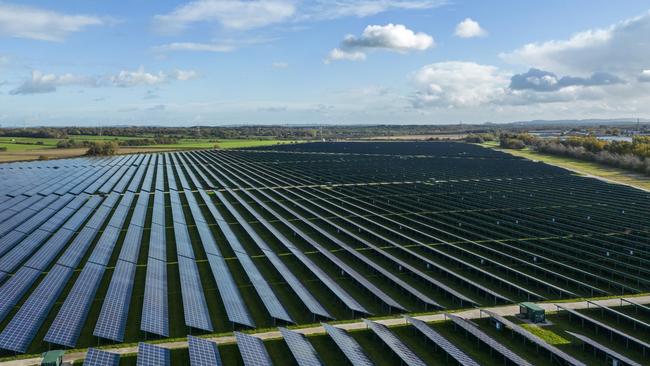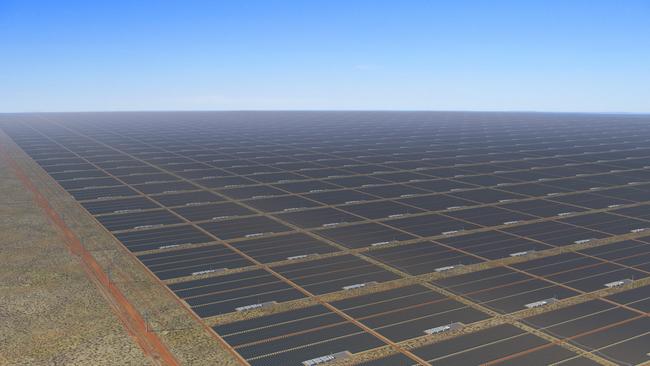Inside the world’s biggest renewable energy project
Sun Cable’s new clean energy project, Australia-Asia Power Link, is the ‘right project at the right time – not just for us and our region, but for the planet’.

-
-
In the next two years, construction will begin in the Northern Territory on what has been billed as the biggest renewable energy project in the world, ever.
This is not mere hyperbole. Constructed by Australian renewable energy company Sun Cable, the vast solar farm and battery storage facility will produce enough megawatts to power new green industries in Darwin and send Australia’s first green electricity exports to Singapore. In fact, the solar power, sent via a 4,200km subsea cable, will supply 15 per cent of the island nation’s electricity needs. Known as the Australia-Asia PowerLink, it will have a solar generating capacity of 17-20 gigawatts (GW) and be capable of delivering 3.2GW of firmed power.
According to Sun Cable founder and CEO David Griffin, the time for mounting such an ambitious project is now.

“Humankind has spent many decades establishing a complex and sophisticated global energy system,” Griffin says, “but it has a fatal flaw that’s leading to the existential crisis of climate change.”
That is no reason to give up however, he adds. Rather, “it is achievable with today’s resources and technology to live in a 100 per cent renewable energy world by 2050.”
This is where the Australia-Asia PowerLink comes in. “With our flagship project, the Australia-Asia PowerLink, Sun Cable is setting out to produce zero emissions electricity from a truly abundant solar resource that will allow society to thrive,” Griffin says.
Good for Australia, good for the planet
The project is valuable on a number of levels, says Damian McNair, Energy Transition Partner at Australia’s biggest professional services firm, PwC Australia.
“At the base level it is incredibly important in the Northern Territory for job creation in the indigenous community, and for Darwin in terms of power supply,” McNair says. “Then you build up a bit and it is creating an export industry for Australia. And then you go up another level and it is involved in bringing renewable energy into Asia. And then finally if you look at it in the context of the geopolitical landscape in Asia Pacific and globally, it feels like it is the right project at the right time – not just for us and our region but for the planet.”
The scheme has the backing of the Australian and Northern Territory governments and funding from some of Australia’s best-known businesspeople, including two billionaire investors and energy transition advocates Mike Cannon-Brookes and Andrew Forrest.
Sun Cable predicts that the first-of-its-kind project will not only bring a significant supply of zero-carbon, reliable and competitively priced power to Darwin, but before the decade is out, it will be supplying up to 15 per cent of Singapore’s electricity needs. The facility will also help to accelerate Singapore and Australia’s progress towards lower emissions, helping both countries achieve their respective climate targets.
What’s more, Sun Cable is expected to cut around eight million tons of CO2 from the atmosphere each year.

Award-winning innovation
In helping to bring the project to fruition, PwC assembled a community of solvers from across its professional services network, involving experts in tax, infrastructure, financial modelling, legal, financial advisory, procurement, economic analysis and communications.
It also conceptualised an Integrated Project Delivery Team and brought together Marsh as the Risk Management Partner and Bechtel, Hatch and SMEC as the Project Delivery Partners, with PwC Australia the Project Advisory Partner.
McNair said collaboration was key while working on this once-in-a-generation project.
“Regardless of whether you worked for Sun Cable, PwC Australia or another specialist brought in to assist in the delivery, when it came to the Australia-Asia PowerLink, all teams were united under the one banner and one goal.
“We wanted to build trust and unite the many entities working on Australia-Asia PowerLink,” he said. “This was a major focus and has worked extremely well. By unifying the team, we were able to navigate highly complex issues,” he said.
The method was so effective, it earned PwC Australia an award for the approach in the Advisory Excellence category at this year’s IPA National Infrastructure Awards.
Just the start

“Sun Cable sits at the forefront of energy transition,” says McNair. “For us, working with Sun Cable is an ethical decision as well as a business decision. Projects like the Australia-Asia Power Link – which delivers sustained outcomes – is very much at the front and centre for PwC Australia.”
For Sun Cable itself, this is just the start. “It is our vision that the Australia-Asia PowerLink will be a foundation stone for many more multi gigawatt scale projects,” says Griffin.
“Australia-Asia PowerLink is the first of many network projects that Sun Cable wants to develop and it is also feasible that Sun Cable could end up as the renewable energy input into other green energy industries in Australia including green steel, green hydrogen and ammonia.”
Dawn of a new era
As governments and private enterprises around the world struggle with the question of how to bring the era of fossil fuel dependence to an end, and the renewable one into being, it can be hard to know exactly where to start, says Griffin, especially considering our energy needs are only continuing to increase.
“By 2050, the world population is expected to grow to 9.8 billion people, with global electricity demand set to more than double from 81 exajoules (the equivalent of one billion gigawatts) in 2020 to 169 exajoules by 2050.”
For McNair, Sun Cable’s work shows how pioneering renewable energy projects can help to address this growing demand. “It is a point in time that I think we will look back on and realise that this was when the world started to change,” McNair says.
“It’s just the start of major energy transition projects … There’s plenty to come.”
This content was produced in association with PwC. Read our policy on commercial content here. Read our policy on commercial content here.



To join the conversation, please log in. Don't have an account? Register
Join the conversation, you are commenting as Logout